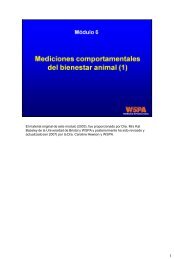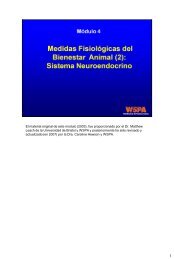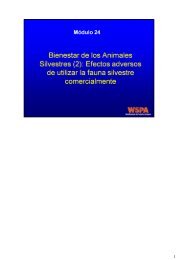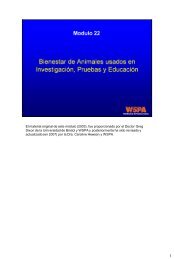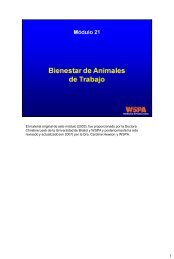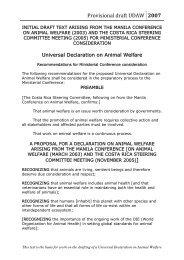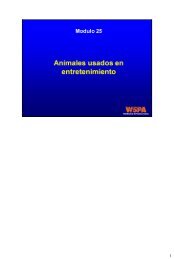Create successful ePaper yourself
Turn your PDF publications into a flip-book with our unique Google optimized e-Paper software.
<strong>Bear</strong>s of the world<strong>Bear</strong> <strong>facts</strong>
Polar bear © Istockphoto / AtlasImagesCover Giant Panda © Istockphoto / ytwong
<strong>Bear</strong>s of the world<strong>Bear</strong> <strong>facts</strong>CONTENTS<strong>Bear</strong> essentialsSight 5Hearing 5Smell 5Behaviour 5Hibernation 6Reproduction 7Threats to bearsHabitat destruction 8Trade in bear products 9Dancing bears 9<strong>Bear</strong> baiting 9Hunting 10Human-bear conflict 10Zoos and circuses 10<strong>Bear</strong> cub rehabilitation and release 11<strong>Bear</strong> safe<strong>Bear</strong> encounters 12Camp set-up 13Cooking 13Food storage 13Garbage disposal 13<strong>Bear</strong> quizQuestion sheet for copying 15<strong>Bear</strong> Facts | 3
BEAR ESSENTIALSSIGHT<strong>Bear</strong>s have good eyesight and colour vision, whichhelps them to spot food such as coloured berriesand fruits. Their eyes are widely spaced and forwardfacing, as in humans, which gives them binocularvision enabling them to judge distances well. As mostbears are active at night, their eyes are speciallyadapted for night vision. Polar bear eyes have aspecial protective membrane, which may helpshield them from ultraviolet light, and help them seeunderwater.HEARING<strong>Bear</strong>s have better hearing than humans and, likedogs, are more sensitive to higher pitched sounds.SMELL<strong>Bear</strong>s rely more on smell than any other sense. Itis believed that this sense is even better developedthan in dogs. They use smell to locate food, mates,and also to avoid danger. <strong>Bear</strong>s are often reportedto travel for several kilometres in a straight line toreach the carcass of an animal, which they havelocated through their acute sense of smell. Polarbears have been observed to smell a seal more than32 kilometres away! It is also believed that bears candetect a human scent many hours after the personhas passed by. <strong>Bear</strong>s use this keen sense of smell tocommunicate with each other. By leaving their scenton trees and vegetation, they are alerting other bearsin the area to their presence.BEHAVIOUR<strong>Bear</strong>s are intelligent, have good memories and arecurious animals; all qualities needed for a lifestylewithin a habitat that is large, varied, and changeablewith the seasons. They need to remember where aparticular food source was found, what plants not toeat, where to find the best fish, and to learn quicklywhat to avoid – including human hunters.<strong>Bear</strong>s are usually solitary, coming together onlybriefly during the mating season. Under certainconditions where there are good food sources, suchas salmon rivers, bears gather and tolerate eachother. They observe a strict hierarchy where thedominant bears get the best fishing sites.European Brown bears in natural habitat<strong>Bear</strong> Facts | 5
Asiatic Black bear in natural habitatCommunication between bears is well developedand involves vocal and visual signals and also theuse of smell. <strong>Bear</strong>s are generally quite silent but usea variety of vocalisations when encountering otherbears. Mother bears also call to their cubs, whichrespond with whimpering, crying, barking and evenhumming. Aggressive behaviour usually involves adirect stare and posturing, or displaying the size oftheir body – often by standing on hind paws. Roaringand displaying a wide-open jaw which exposes theteeth are also used in dominance displays. If displaysfail, bears will fight and can suffer serious wounds.<strong>Bear</strong>s also use their sense of smell to find receptivemates for breeding.All bears can swim and all, except the Polar bear, aregood at climbing trees.HIBERNATIONHibernation is a state of inactivity and dormancythat some animals are able to undergo to enablethem to survive the harsh winter period when thereis a lack of food.Although we often say that bears hibernate, this isnot strictly correct. True hibernators go into such adeep sleep that they are difficult to wake and may<strong>Bear</strong> Facts | 6appear dead. Animals store up fat reserves beforethe onset of winter and then go into a deepcomatose state from which they are not easilyroused. Their metabolic rate and body temperaturedrop significantly during hibernation. In the groundsquirrel, for example, the breathing rate dropsfrom around 200 breaths per minute to five perminute, and the heart rate from 150 beats perminute to five. Their body temperature drops from32.2 °C to 4.4 °C (89.6 °F to 39.9 °F), but if theweather gets too cold, they will awaken to warmup, and then return to sleep. True hibernatorsinclude hedgehogs, woodchucks, marmots,dormice, squirrels, and some bats, frogs, toads andtortoises.However in habitats with harsh winters, bears gointo a state of dormancy that is their own form ofhibernation. Their body temperature and metabolicrate drops slightly, but they can awaken and movearound during their hibernating period, and mayeven go outside their den. Body temperatures onlydrop by 2 to 6 °C (3-10 °F).<strong>Bear</strong>s can go three to six months without anyfood or drink during their ‘hibernation’, and do noturinate or defecate during this time. Females can,however, give birth and nurse their cubs while theyare hidden away from the world.
Females with cubs tend to emerge from their denslater than other bears. A bear’s winter sleepingheart rate is much lower; its breathing rate is 50 percent, and its oxygen consumption only 40 per centof normal levels.Not all bears hibernate. Brown bears, AmericanBlack bears and Asiatic Black bears living in coldclimates will hibernate but those living in warmerclimates, such as the Giant Panda, Spectacled,Sun and Sloth bears remain active throughouttheir winter season. The reason for this is thathibernation is not simply a means for the animalto escape from the extremes of the winter; itis a physiological response to the seasonaldisappearance of its normal food supply.In areas where winter conditions are harsh, suchas the more northerly parts of America andEurasia, the bears’ main source of food – plants,berries, fruits etc. – becomes scarce or disappearsaltogether. In the Polar bear’s habitat, fish and sealsare a constant source of food so the bears do nothibernate, despite the cold weather. Female Polarbears do hibernate, however, if they are going tohave cubs. In these areas during the autumn, bearsfatten themselves by eating enormous quantities offood, often up to 20,000 calories per day! This isstored in the body as a layer of fat, which can beup to six inches thick. This stored energy will beslowly used up during its long sleep so when a bearemerges after months in its den it may have lost upto a third of its body weight.The dens where the bears hide themselves awayfor the winter vary in design and location. Theycan either be in natural caves, hollows, under largeboulders or even in old tree trunks. A bear mayeven dig a chamber in the ground. Polar bears digdens in the snow. Bedding – leaves and moss – isdragged into the den to insulate it from the coldand to camouflage it.Some bears use the same den year after year, whileothers find or dig a new one each time.REPRODUCTIONFemale Polar bears (sows) exhibit delayedimplantation, which ensures that the fertilised eggdoes not implant in the wall of the womb untilOctober or November. It then takes around twomonths to develop into a bear cub, which will beborn in the den around January. The reason fordelaying implantation is to ensure that the cub isborn in the safety of the hibernation den, but it alsoacts as a safety mechanism to ensure that the femalecan survive pregnancy. If there is insufficient foodavailable in the autumn (fall) the female may not bein good physical condition to undertake the heavynutritional demands of pregnancy and feeding a cub.In this case the egg will not implant but be aborted.<strong>Bear</strong> milk is very rich, having a fat content as high as46 per cent, compared to human milk at 4 per cent.This rich milk allows the tiny, blind, almost nakedcubs to grow at a rapid rate.(left): Natural bear den(right): European Brown bear resting<strong>Bear</strong> Facts | 7
THREATSTO BEARSAll eight species of bear are under threat allover the world – mainly from human activities.The main threat is the rapid and continueddestruction of their habitat. However, bears arealso caught from the wild for zoos and circuses;they are killed for their fur, meat, gall bladdersand paws; they are farmed for their bile and usedin cruel spectacles and sports such as beardancing and bear baiting.All eight bear species are listed in eitherAppendix I or II of the Convention on InternationalTrade in Endangered Species of Wild Fauna andFlora (CITES). CITES is an international agreementto which over 160 countries have signed up. Itwas established in 1973 to control the trade inendangered wild animal and plant species. Speciesare listed in three appendices, according to the levelof threat. Species listed in Appendix I receive thegreatest level of protection from international trade,while those in Appendix II and III receive lower levelsof protection. Please see the CITES website forfurther information (www.cites.org).Destroyed bear habitat after forest fireOne can also look to the International Unionfor Conservation of Nature (IUCN) Red List ofThreatened Species to find out more about thestatus of the eight bear species. This list providestaxonomic, distribution and conservation statusinformation about plants and animals that have beenassessed using the IUCN Red List Categories andCriteria, and each species is ranked on a scale of riskof global extinction, ranging from Least Concern toExtinct. For more information see the IUCN Red Listwebsite (www.iucnredlist.org).HABITAT DESTRUCTIONAs with so many other species around the world,loss of habitat through deforestation, humanencroachment, and agriculture are having a massivedetrimental effect on many bear populations. Withoutproperly protected habitats, large enough to sustainviable population levels, many species of bear willsimply not be able to survive in the wild.<strong>Bear</strong>s once lived throughout Europe, but the vastforests which once covered the land have beendestroyed to make way for the growth of towns, citiesand motorways as well as vast agricultural fields.Brown bears were hunted to extinction in Britain’sforests in the 10th century and in Western Europethese animals have disappeared from most areas.Spain, Greece and Italy have small populations left– around 100 bears in each country. In France thereare only a handful of Brown bears left, isolated in thesouthern area of the French Pyrenees.<strong>Bear</strong>s in Asia are threatened with massivedeforestation of their habitat. In Indonesia the loggingand mining industry and forest fires are destroyingthousands of square kilometres of prime foresthabitat each year.Polar bears live in the most inhospitable of areas –the ice packs of the Arctic – but even their habitatis under severe threat. This is mainly in the form ofpollution from oil spills resulting from the massive oilexploration being undertaken in the region. There isalso a growing threat from climate change which isslowly warming the northern ice packs and meltingthe ice from beneath the paws of these bears.© Digital Visions<strong>Bear</strong> Facts | 8
Asiatic Black bear in Chinesebear bile farm<strong>Bear</strong> bile products© GKU/ <strong>WSPA</strong><strong>Bear</strong> baiting© <strong>WSPA</strong>/ Mark RissiTRADE IN BEAR PRODUCTSThe illegal trade in bear parts is common in manyAsian countries. High prices can be fetched for partssuch as gall bladders, which are used in TraditionalAsian Medicine (TAM) because of their supposedmedicinal properties. <strong>Bear</strong> teeth and claws are soldas trinkets and various parts of the bear are sold asfood delicacies. There is also a huge demand forbear bile which is met by the killing of wild bears andby a practice known as bear farming. This cruel andunnecessary practice is most widespread in Chinabut also occurs in Korea and Vietnam and leads tosevere distress and pain for the bears. <strong>Bear</strong>s are keptin cramped cages, hardly big enough for them to turnaround in. Many bears in Asia suffer a bile extractionprocess that involves inserting a tube into an openingmade directly into the gall bladder to extract biledaily. Farmed bears have not been and cannot bere-introduced to the wild. It is illegal to commerciallyexport bear parts, including gall bladders and bile,under the Convention of the International Trade inEndangered Species (CITES), but <strong>WSPA</strong> investigatorshave revealed that some Asian bear farmers doexport their products across the world.BEAR BAITING<strong>Bear</strong> baiting is a cruel sport that involves settingfighting dogs upon tethered bears. It has been illegalin most countries for over 100 years but, despitebeing illegal, it still persists today in rural Pakistan.Setting fighting dogs against bears inflicts appallinginjuries on both species. <strong>WSPA</strong>’s first investigationin Pakistan, undertaken in 1993, found evidenceof 80 different contests involving 300 bears. Butnow, as a result of <strong>WSPA</strong>’s continued efforts, bearbaiting has reduced significantly. Through continuedco-operation with the Pakistan authorities, <strong>WSPA</strong>aims to stop bear baiting for good.DANCING BEARSThe life of a dancing bearbegins early on as cubs areusually poached from the wild.Forced to undergo a brutaltraining regime, the cubs havetheir nose or lips pierced witha hot metal rod in order toinsert a thick iron ring or rope;this wound heals and becomescalloused, but if it getsinfected, it can also be painful.From that day on, the bearsare slaves to the whim of their owners, and throughaversive conditioning, the bears learn to dance oncommand in order to avoid being punished or hitby their owners. The cubs often have some teethremoved and claws shortened to make them easierto handle and, as a result, they can never be returnedto the wild. <strong>WSPA</strong> has eradicated the use of dancingbears in Greece and Turkey by helping governmentsto confiscate bears and re-home them in safe,forested sanctuary enclosures. <strong>WSPA</strong> is working withlocal groups on a dancing bear eradication project inIndia in rural areas, as it has already been eradicatedin urban and accessible areas. The practice ofdancing bears remains a reality in Pakistan.© WTI<strong>Bear</strong> Facts | 9Dancing bear on the streets of India
HUNTINGReasons for hunting vary. In many parts of the world,bear hunting is regarded as a sport in itself, with thebody of the bear being a much sought after ‘trophy’.In other countries it is the bear’s body parts that fuelhunting activities. <strong>Bear</strong>s are hunted for their meat,their gall bladders and bile, and for body parts suchas the feet and claws, which fetch high prices on theblack market. Adult females are also often shot sothat their cubs can be taken and sold as pets andtourist attractions, never to return to the wild.HUMAN–BEAR CONFLICTAcross the world people and bears share the same(or neighbouring) lands. This proximity can generatewhat is called conflict between humans and bearsdue to the competition for resources. <strong>Bear</strong>s spendtheir days in search of food and are attracted to easyfood sources such as crops, cultivated beehivesor even rubbish bins, especially if these are in ornext to lands in which they live. Experts are workingtogether to continuously develop solutions to thesehuman–bear conflicts. Methods to address conflictneed to include all the people involved (farmers,government representatives, NGOs, bear experts etc)to tackle the issue from all angles. On the groundthe attracting foods need to be protected from easyaccess by the bears (eg raising beehives on highplatforms) but also good national and internationalpolicies need to be set to help and protect bothpeople and bears affected by the conflict. Thesepolicies tackle the management of bear habitat, bearpopulation but also how people live near bears. Onlywhen all aspects of the conflict are addressed can along term co-existence occur between people andbears.ZOOS AND CIRCUSES<strong>Bear</strong>s are also very common in zoos and animalparks where living conditions are often extremelypoor. Many captive bears languish for years in barrenenclosures with little or no environmental enrichment.Many zoos have no understanding of the needs ofanimals such as bears. In the wild these animalswould roam over many kilometres each day, climbtrees, dig for insects and catch fish in rivers whereasin many zoos all they have is a small concreteenclosure. In Japan this is taken to the extreme inthe ‘bear parks’ which often have 50 bears in eachconcrete pit. With nothing to occupy them theseanimals frequently end up fighting and receivingserious wounds. <strong>Bear</strong>s are also regularly used incircuses and animal shows to entertain the public.When the bears are not performing degrading tricksfor the audiences, they are kept in cramped cagestravelling from one town to the next. One of the waysto stop this cruelty is to educate the public as to thetrue needs of bears.<strong>Bear</strong> Facts | 10Wild bears feeding in garbage bins
(above): Japanese bear park enclosure(top right): Brown bear in a zoo(right): Circus showBEAR CUB REHABILITATIONAND RELEASEAcross the world, large numbers of wild bear cubsand juveniles are orphaned due to natural causes (viaabandonment or death of their mother) or as a resultof human interference such as human–bear conflictsituations (eg. traffic accidents, retaliations), huntingor poaching. These orphaned cubs are typically leftto die, killed (inhumanely or euthanized) or placedin life long captivity, either by the authorities suchas a zoo or kept by locals as pets or used in privatecollections in conditions unsuitable for the physicaland behavioural requirements of this wild animal.With growing international recognition, rehabilitationand release programmes continue to demonstratethey are a viable alternative, providing the orphanedanimal with a second chance at a life in its naturalenvironment in the wild.<strong>Bear</strong> Facts | 11
BEAR SAFEAn increasing number of people are living orholidaying in bear country. However many peopledo not know how to live safely with their wildneighbours. A bear is quickly labelled a nuisanceor a pest when it is attracted by the smells of ourfood and rubbish. All too often, the problem issolved by killing the bear. But curious bears canbe discouraged from looking for an easy meal.Carelessly stored food, rubbish, even pet food,can all attract bears, making them a potentialproblem. By eliminating the source of theattraction, we can eliminate visits from ‘nuisance’bears – and keep other bears from becoming aproblem in the future.<strong>Bear</strong>s are opportunistic omnivores that feed on avariety of foods, including berries, vegetation, andinsects. Some species eat meat, as well as fish.<strong>Bear</strong>s will also eat and enjoy many of the same foodsas humans eat.<strong>Bear</strong>s are wild animals, and should not beapproached if you encounter them in the wild.Contrary to popular perception, bears are notusually aggressive towards humans and will tryto avoid humans as much as possible. They arenaturally shy and typically only act aggressively whenthreatened. However, hungry bears may appear iflured by the smells from a barbecue or rubbish bin.They will remember an easy source of food and willkeep returning if the food source is not disposed ofproperly.A bear’s sense of smell and hearing are far superiorto that of humans, and their eyesight is at least asgood.Despite their somewhat lumbering appearance,bears are fast and are also extremely strong. Brownbears and American Black bears, for example, canrun as fast as a racehorse over short distances.<strong>Bear</strong>s have been known to bend open car doors andbreak open windows when they can smell food.Humans and bears can live togetherEncounters with aggressive bears are extremely rareand attacks are even rarer.Female bears only rarely attack defensively and aremost likely to try and warn you off or escape andcollect their cubs later, but it is best to stay away fromall cubs even if they are alone. The mother is probablynearby. A bear that has reared on its hind legs rarelyattacks – they generally attack on all fours. A bearstanding on its hind legs is usually trying to catch yourscent or trying to get a better look at you.There is no foolproof way of dealing with a bearencounter (each bear and encounter is different) butthe best approach is to play it safe.DO NOT approach it.DO NOT leave food for the bear.This encourages further problems. If you see a bear,remain watchful.DO NOT run, but slowly back away.Being too close to a bear may promote aggressivebehaviour from the bear.This includes running towards you, making loudnoises, or swatting the ground.If the bear gets closer, talk loudly or shout at it.DO NOT act aggressively but, if the bearapproaches you, try to intimidate it.Act together as a group if you have companions.Make yourself look as large as possible(for example move to higher ground). Thrownon-food objects such as rocks at the bear.Use a deterrent such as a stout stick.<strong>Bear</strong> Facts | 12
CAMP SET-UPCamping next to a river or stream makes it hard forbears to hear you. Avoid setting up camp near naturalbear food sources. Stay away from abundant foodsources (e.g. berry bushes) and dead animals – bearsmay be foraging in the area or protecting a carcass.COOKINGBe alert when cooking food outdoors. If bears arenearby, they may be attracted by the smell. Cookingareas should be well away from your tents (at least100 metres downwind).FOOD STORAGEFood should be stored in a vehicle or placed inseveral layers of plastic bags and suspendedbetween two trees around seven metres apart atleast three to five metres above the ground (and 100metres away from your camp). Remove the clothesyou wore while cooking before going to sleep, as theymay smell of the food, and store them in a vehicleor hang suspended with your food. When camping,don’t bring food into your tent – this includestoothpaste, perfume and chocolate bars. Burn foodscraps and wash all dishes immediately after eating.GARBAGE DISPOSALDon’t leave food, rubbish or pet food outside wherebears will smell it. Store rubbish indoors, outside inbear-proof containers or suspended between trees(see food storage above).© Diane Ronayne <strong>Bear</strong> Facts | 13
QUIZ ANSWERS1. Brown bear (see species <strong>facts</strong>heet for distribution)2. Giant Panda. Endangered due to deforestation in theirbamboo habitat.3. Largest: Polar bear. Smallest: Sun bear.4. Africa, Australia and Antarctica5. Fore paws have webbed membranes to assistswimming. Thick layer of subcutaneous fat protectsagainst freezing temperatures. Small ears protectagainst excess heat loss. Soles of feet are padded withfur and covered by small, soft bumps know as papillae,which give a better grip on the ice.6. Long powerful claws to break open termite mounds.Naked lips are capable of protruding, and the innerpair of incisors are missing, which forms a gap throughwhich termites can be sucked.7. They have six digits on front paws. This extra digitis developed from the wrist bone, and is used as anopposable thumb by which the bear can grasp bambooshoots when feeding.8. Moon bear. They have a distinctive white patch on thechest, which is often in the shape of a V or a crescent.9. Spectacled bear. Mainly found in fragmented smallpopulations in the Andes Mountains in Venezuela,Colombia, Peru, Ecuador and Bolivia.11. A state of inactivity and dormancy. Brown bears,American Black bears and Asiatic Black bears hibernateas a physiological response to seasonal disappearanceof normal food supply.12. They feed on a mixed diet of plant and animal material.<strong>Bear</strong>s eat: plants, fruits, nuts, berries, fish, meat andcarrion. Giant Pandas eat the shoots, leaves, stemsand branches of around 30 species of bamboo.Deforestation of bamboo habitat affects Panda survivalin wild.13. Habitat destruction. Trade in bear products. Use inentertainment (dancing bears, bear baiting, circusesand zoos). Hunting. Human–bear conflict.14. a) Pollution due to oil exploration, potentially toxicchemicals (such as PCBs) in Arctic environment andclimate change shortening hunting season with icebreaking up earlier.b) Habitat loss through deforestation, humanencroachment (growth of towns, cities and motorways),and agriculture reduces areas available for bears to liveso populations become fragmented.15. Include: capture from wild, inadequate housing (small,lacking in adequate environmental enrichment), poordiet, overcrowding and cruel training methods.10. Five States: Alaska, Wyoming, Montana, Idaho andWashington. Other countries include: Russia, Japan,Greece, Italy, Spain (see species fact sheet map for fulldistribution).<strong>Bear</strong> Facts | 14
<strong>Bear</strong> <strong>facts</strong>QUIZ & ACTIVITIES1. Which bear species has the most widespreaddistribution?2. What is the rarest species of bear and whyare there so few of them?3. Which is the largest species of bear in theworld and which is the smallest?4. Which continents do not have any bears?5. Describe three ways Polar bears are adaptedto living in their environment.6. What specialised features have Sloth bearsevolved to cope with their diet?7. What is unusual about the front paws of theGiant Panda?8. What is the other name for the Asiatic Blackbear and how did it get its name?10. In how many US states can you find theBrown bear? In which other countries canit be found?11. What is hibernation? Which bear specieshibernate and what is the main reason for this?12. <strong>Bear</strong>s are omnivorous. What does this mean?Name some of the foods that bears eat.Which bear has the most restricted diet andhow might this affect its survival in the wild?13. List five threats to bears worldwide.14. Many bears are threatened by habitatdestruction, how does this threat affect:a) Polar bearsb) Brown bears in Europe?15. What are the main welfare concerns for bearskept in captivity in zoos and circuses?9. Which is the only bear to inhabit South Americaand in which countries can it be found?• Using the world map provided (and any atlasavailable to you) list, for each bear species,the countries where they can be found.• Using information provided here, and in otherbooks, write a detailed account of the life ofone species of bear.• Write an account of bear farming (for bear bile)and the illegal trade in bear products. Usethe information provided or check the <strong>WSPA</strong>website (www.wspa-international.org).• Design a ‘bear safe’ poster, which could beused to inform the public living or holidayingin bear country.• Imagine you are a bear in any one of thesesituations:a) a dancing bearb) a bear in a bear bile cagec) a bear in a circus or zooWrite an account of a day in the life of such abear.• Carry out the following role-play exercise: youare taking part in a radio or TV discussionprogramme on the subject of bear farming.One person each needs to take the part of:a) a bear bile farmerb) a government spokespersonc) a TAM (traditional Asian medicine) traderd) an animal welfare investigatore) the interviewer.Each person will need to be able to defend hisor her position in the debate. The rest of theclass will be the studio audience.<strong>Bear</strong> Facts | 15
<strong>WSPA</strong> INTERNATIONAL222 Gray’s Inn RoadLondon, WC1X 8HBUnited KingdomT: +44 (0)20 7239 0500F: +44 (0)20 7239 0653E: education@wspa-international.orgW: www.wspa-international.org© 2011 <strong>WSPA</strong>All photographs are copyright <strong>WSPA</strong> unless marked.This publication may be photocopied for educational purposes only.www.wspa-international.org



